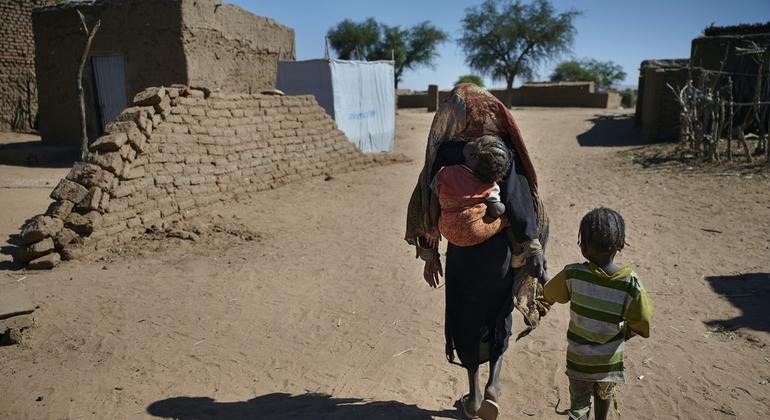[ad_1]
Fighting between the Sudanese army and rival military the Rapid Support Forces (RSF), who have been battling for more than year, recently intensified in the North Darfur city.
Civilians are under attack from all sides and the news of reported casualties and human rights abuses are appalling, UN Resident and Humanitarian Coordinator for Sudan Clementine Nkweta-Salami said in a statement.
‘Deeply worrying reports’
“Families, including children and elderly people, are being prevented from leaving the city as they search for safety,” she said.
“We are receiving deeply worrying reports that medical facilities, displacement camps and critical civilian infrastructure have been targeted by parties to the conflict.”
Ms. Nkweta-Salami added that many parts of El Fasher have been left without electricity or water and a growing proportion of the population has limited access to food, healthcare and other basic necessities and essential services.
Appeal to the parties
“After more than a year of brutal conflict, families have exhausted their scarce resources and their resilience is being eroded with each day of violence,” she said.
The top UN aid official in the country stressed that all parties must avoid using explosive weapons in populated areas and take all feasible precautions to protect civilians and civilian infrastructure.
“Wars have rules that must be respected by all, no matter what,” she said.
Conflict displaces millions
Meanwhile, the war has displaced more than seven million people inside Sudan, more than half of them children, according to the UN humanitarian affairs office, OCHA, citing data from the UN International Organization for Migration (IOM).
This is in addition to the estimated two million who have fled to neighbouring countries since the conflict erupted in April 2023.
The UN and partners continue to step up efforts to respond to rising hunger and food insecurity in Sudan. Some 18 million people across the country are going hungry and five million are on the brink of famine.
Food on the move
The UN World Food Programme (WFP) reported that 1,200 metric tonnes of food supplies for some 116,000 people are being transported across the Darfur region and nearing final destinations in Central Darfur and 12 locations across South Darfur, including displacement camps in Nyala.
The supplies are from a WFP convoy that crossed into Sudan from Chad last week.
Food distributions are also ongoing for 135,000 people in South Kordofan state as WFP reiterated that aid must safely reach vulnerable communities.
“No bullets. One rose for each child.”These were the powerful words of 10-year-old Majd during a psychosocial session delivered by UNICEF and partners.
‘Catastrophic consequences’ for children and mothers
Separately, WFP alongside the UN Children’s Fund (UNICEF) and the World Health Organization (WHO), issued a stark warning of the significant deterioration in the nutrition status of children and mothers due to the war.
“Sudan is facing an ever-increasing risk of conflict-induced famine that will have catastrophic consequences including the loss of life, especially among young children,” they said on Thursday.
Recent analysis conducted by the agencies highlights how the conflict is worsening the drivers of child malnutrition, which include lack of access to nutritious food, safe drinking water and sanitation, as well as increased risk of disease.
The situation is further compounded by the massive displacement of people fleeing to safety. Furthermore, humanitarian access has been severely impacted by the fighting.
Childhood malnutrition crisis
The UN agencies said child malnutrition is at emergency levels. In Central Darfur, acute malnutrition is estimated to be at 15.6 percent among under-fives, and close to 30 per cent at the ZamZam camp in North Darfur, home to thousands of internally displaced people.
Acute malnutrition is life-threatening, they explained, as malnourished children are up to 11 times more likely to die than their well-nourished counterparts.
Levels of malnutrition are particularly worrying among pregnant and breastfeeding mothers, they added, pointing to a screening carried out last month by medical charity MSF in ZamZam camp.
Over 33 percent of pregnant and breastfeeding women there are malnourished, indicating that they are likely sacrificing their own needs to feed their children.
Next generation at risk
“This situation poses an incredible risk not only for the health of mothers, but also for the next generation of Sudan’s children,” they said. “As much as 30 percent of child malnutrition begins in utero, so children born to malnourished mothers are likely to be already malnourished themselves.”
The agencies fear that the situation for children and mothers will only worsen over the coming months, noting that the rainy season, which starts in June, will cut off communities and raise disease rates.
“Sudan is also entering the lean season, a time between harvests when food stocks traditionally run low,” they added. “This is particularly pertinent this year, as reports are already indicating that agricultural production in 2023 was below normal, due to insecurity and displacement.”
The agencies called for immediate, unimpeded and consistent access to communities who are suffering the worst effects of the conflict, through all possible crossline and cross-border routes.
They also appealed for a de-escalation of the situation in El Fasher, a nationwide ceasefire and a scale-up in donor support, warning that “the window to avert the worst is rapidly closing”.
[ad_2]
Source link



